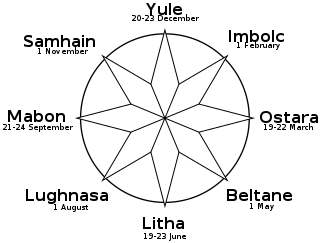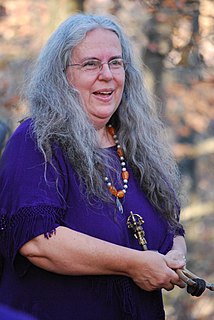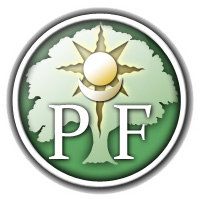Related Research Articles

Modern paganism, also known as contemporary paganism and neopaganism, is a collective term for religious movements influenced by or derived from the various historical pagan beliefs of pre-modern peoples. Although they share similarities, contemporary pagan religious movements are diverse, and do not share a single set of beliefs, practices, or texts. Most academics who study the phenomenon treat it as a movement that is divided into different religions; others characterize it as a single religion of which different pagan faiths are denominations.

Wicca is a modern pagan religion. Scholars of religion categorise it as both a new religious movement and as part of the occultist stream of Western esotericism. It was developed in England during the first half of the 20th century and was introduced to the public in 1954 by Gerald Gardner, a retired British civil servant. Wicca draws upon a diverse set of ancient pagan and 20th-century hermetic motifs for its theological structure and ritual practices.

The Wheel of the Year is an annual cycle of seasonal festivals, observed by many modern pagans, consisting of the year's chief solar events and the midpoints between them. While names for each festival vary among diverse pagan traditions, syncretic treatments often refer to the four solar events as "quarter days", with the four midpoint events as "cross-quarter days". Differing sects of modern paganism also vary regarding the precise timing of each celebration, based on distinctions such as lunar phase and geographic hemisphere.

The Goddess movement includes spiritual beliefs or practices which emerged predominantly in North America, Western Europe, Australia, and New Zealand in the 1970s. The movement grew as a reaction to perceptions of predominant organized religion as male-dominated, and makes use of goddess worship and can include a focus on female people, or on one or more understandings of gender or femininity.

Drawing Down the Moon: Witches, Druids, Goddess-Worshippers, and Other Pagans in America Today is a sociological study of contemporary Paganism in the United States written by the American Wiccan and journalist Margot Adler. First published in 1979 by Viking Press, it was later republished in a revised and expanded edition by Beacon Press in 1986, with third and fourth revised editions being brought out by Penguin Books in 1996 and then 2006 respectively.
The Rule of Three is a religious tenet held by some Wiccans, Neo-Pagans and occultists. It states that whatever energy a person puts out into the world, be it positive or negative, will be returned to that person three times. Some subscribe to a variant of this law in which return is not necessarily threefold.

Selena Fox is a Wiccan priestess, interfaith minister, environmentalist, pagan elder, author, and lecturer in the fields of pagan studies, ecopsychology, and comparative religion.

The Pagan Federation is a UK-based voluntary organisation, founded as the Pagan Front, with the objective of providing information and countering misconceptions about Neopaganism. It was formed in 1971, and campaigns for the religious rights of Neo-pagans and educates both civic bodies and the general public about Paganism. Pagan Federation is a constituted voluntary organisation, registered as a private Company limited by guarantee, with exemption for use of 'limited' with Companies House on 22 August 2000, with its nature listed as a Religious Organisation. The memorandum of the association lists the objects of the Pagan Federation as providing services for Pagans in the UK and abroad, providing information about Paganism to the public and all interested bodies, educating the public about Pagan beliefs and traditions, providing access to Pagan celebrations, and providing pastoral care for Pagans in the community including those in hospitals and prisons.
Phyllis Curott who goes under the craft name Aradia, is a Wiccan priestess, attorney, and author.

Philip Heselton is a retired British conservation officer, a Wiccan initiate, and a writer on the subjects of Wicca, Paganism, and Earth mysteries. He is best known for two books, Wiccan Roots: Gerald Gardner and the Modern Witchcraft Revival and Gerald Gardner and the Cauldron of Inspiration, which gather historical evidence surrounding the New Forest coven and the origins of Gardnerian Wicca.

Wiccan morality is largely expressed in the Wiccan Rede: 'An' ye harm none, do what ye will' - old-fashioned language for 'as long as you aren't harming anyone, do as you wish'. While this could be interpreted to mean "do no harm at all," it is usually interpreted as a declaration of the freedom to act, along with the necessity of thinking through and taking responsibility for the consequences of one's actions.
Neopagans are a religious minority in every country where they exist and have been subject to religious discrimination and/or religious persecution. The largest neopagan communities are in North America and the United Kingdom, and the issue of discrimination receives most attention in those locations, but there are also reports from Australia and Greece.
Neopaganism in the United States is represented by widely different movements and organizations. The largest Neopagan religious movement is Wicca, followed by Neodruidism. Both of these religions or spiritual paths were introduced during the 1950s and 1960s from Great Britain. Germanic Neopaganism and Kemetism appeared in the US in the early 1970s. Hellenic Neopaganism appeared in the 1990s.

Vivianne Crowley is an author, university lecturer, psychologist, and a High Priestess and teacher of the Wiccan religion. She was initiated into the London coven of Alex Sanders at the age of eighteen, but later joined a Gardnerian coven in the famous Whitecroft line derived from Eleanor Bone, and so she was one of few people in the seventies to be part of both traditions.

The modern pagan movement in the United Kingdom is primarily represented by Wicca and Witchcraft religions, Druidry, and Heathenry. 74,631 people in England, Scotland and Wales identified as either as Pagan or a member of a specific modern pagan group in the 2011 UK Census.

Madeline Montalban was an English astrologer and ceremonial magician. She co-founded the esoteric organisation known as the Order of the Morning Star (OMS), through which she propagated her own form of Luciferianism.
Minnesota's Twin Cities region is home to a large community of Wiccans, Witches, Druids, Heathens, and a number of Pagan organizations. Some neopagans in the USA refer to the area as Paganistan, a term coined by linguist, poet, and humorist Steven Posch in 1989, which he then used in the title of his spoken word album Radio Paganistan : Folktales of the Urban Witches.
Pagan studies is the multidisciplinary academic field devoted to the study of modern paganism, a broad assortment of modern religious movements, which are typically influenced by or claiming to be derived from the various pagan beliefs of premodern Europe. Pagan studies embrace a variety of different scholarly approaches to studying such religions, drawing from history, sociology, anthropology, archaeology, folkloristics, theology and other religious studies.
The Cauldron was a non-profit, independent, esoteric magazine featuring in-depth articles on traditional witchcraft, Wicca, ancient and modern Paganism, magic, and folklore. It was published quarterly in the UK in February, May, August, and November between 1976 and 2015. It was founded to cater for pagan witches, giving space in particular to non-Gardnerian traditions of witchcraft and so provided some balance to The Wiccan, the mouthpiece of the Pagan Front. During its lifetime The Cauldron was edited by Michael Howard who "has been active among pagans and ritual magicians since the early 1960s".

Modern paganviews on LGBT people vary considerably among different paths, sects, and belief systems. LGBT individuals comprise a much larger percentage of the population in neopagan circles than larger, mainstream religious populations. There are some popular neopagan traditions which have beliefs often in conflict with the LGBT community, and there are also traditions accepting of, created by, or led by LGBT individuals. The majority of conflicts concern heteronormativity and cisnormativity.
References
- ↑ "Pagan Dawn". Exact Editions. Retrieved 12 June 2020.
- ↑ Davy, Barbara Jane (2007). Introduction to pagan studies. Rowman Altamira. p. 45. ISBN 978-0-7591-0819-6 . Retrieved 30 January 2012.
- ↑ Johnston, Hannah E.; Aloi, Peg (2007). The new generation witches: teenage witchcraft in contemporary culture. Ashgate. p. 48. ISBN 978-0-7546-5784-2 . Retrieved 30 January 2012.
- ↑ Simon Coleman; Peter Collins (2 March 2017). Religion, Identity and Change: Perspectives on Global Transformations. Taylor & Francis. p. 176. ISBN 978-1-351-90487-2.